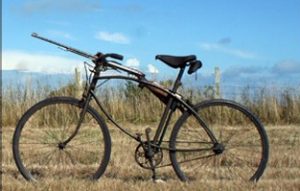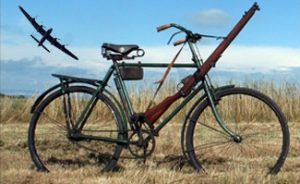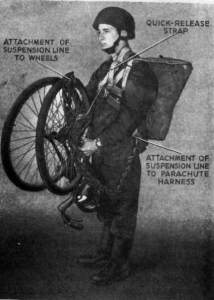worls war i

 When we think about war machines, we think of planes, tanks, ships, and even horses, but we very seldom…if ever, think of bicycles. Nevertheless, bicycles were used in a number of wars, and even continue to be used to this day. The late 19th century brought several experiments into the possible role of bicycles and cycling within military establishments, primarily because they can carry more equipment and travel longer distances than walking soldiers could. The development of pneumatic tires coupled with shorter, sturdier frames in the late 19th century led military establishments to investigate the possibility of bicycles in combat. To some extent, bicyclists took over the functions of dragoons, especially as messengers and scouts, substituting for horses in warfare. Bicycle units or detachments were in existence by the end of the 19th century in most armies.
When we think about war machines, we think of planes, tanks, ships, and even horses, but we very seldom…if ever, think of bicycles. Nevertheless, bicycles were used in a number of wars, and even continue to be used to this day. The late 19th century brought several experiments into the possible role of bicycles and cycling within military establishments, primarily because they can carry more equipment and travel longer distances than walking soldiers could. The development of pneumatic tires coupled with shorter, sturdier frames in the late 19th century led military establishments to investigate the possibility of bicycles in combat. To some extent, bicyclists took over the functions of dragoons, especially as messengers and scouts, substituting for horses in warfare. Bicycle units or detachments were in existence by the end of the 19th century in most armies.
By World War I, the level terrain in Belgian was well used by military cyclists, prior to the onset of trench  warfare. Each of the four Belgian carabinier battalions included a company of cyclists, equipped with a brand of folding, portable bicycle named the Belgica. A regimental cyclist school gave training in map reading, reconnaissance, reporting, and the carrying of verbal messages. Attention was paid to the maintenance and repair of the machine itself. The bicycle could be used to ride when it was feasible, and carried when the pat was not suitable to riding. The bicycle made no noise, so unless the trail was littered with twigs, the bicycle make very little noise. Sneaking up on the enemy was possible.
warfare. Each of the four Belgian carabinier battalions included a company of cyclists, equipped with a brand of folding, portable bicycle named the Belgica. A regimental cyclist school gave training in map reading, reconnaissance, reporting, and the carrying of verbal messages. Attention was paid to the maintenance and repair of the machine itself. The bicycle could be used to ride when it was feasible, and carried when the pat was not suitable to riding. The bicycle made no noise, so unless the trail was littered with twigs, the bicycle make very little noise. Sneaking up on the enemy was possible.
In the United States, the most extensive experimentation on bicycle units was carried out by 1st Lieutenant Moss, of the 25th United States Infantry (Colored), which was made up of African American infantry soldiers with European American officers. Using a variety of cycle models, Moss and his troops carried out extensive bicycle journeys covering between 800 and 1,900 miles. Late in the 19th century, the United States Army tested the bicycle’s suitability for cross-country troop transport. Buffalo Soldiers stationed in Montana rode bicycles across roadless landscapes for hundreds of miles at high speed. The “wheelmen” traveled the 1,900 Miles to Saint Louis, Missouri in 34 days with an average speed of over 6 miles per hour. The bicycles were even used in the paratrooper deployment. These bicycles not only folded up, but they were equipped with an on board rifle. I don’t know how hard it was to handle a gun while riding a bike, but I’m sure it was a relief to have your gun right there.
The first known use of the bicycle in combat occurred during the Jameson Raid, in which cyclists carried messages. In the Second Boer War, military cyclists were used primarily as scouts and messengers. One unit  patrolled railroad lines on specially constructed tandem bicycles that were fixed to the rails. Several raids were conducted by cycle-mounted infantry on both sides; the most famous unit was the Theron se Verkenningskorps (Theron Reconnaissance Corps) or TVK, a Boer unit led by the scout Daniel Theron, whom British commander Lord Roberts described as “the hardest thorn in the flesh of the British advance.” Roberts placed a reward of £1,000 on Theron’s head…dead or alive…and dispatched 4,000 soldiers to find and eliminate the TVK. While scouting alone on a road near Gatsrand, about 3.7 miles north of present-day Fochville, he encountered seven members of Marshall’s Horse and was killed in action.
patrolled railroad lines on specially constructed tandem bicycles that were fixed to the rails. Several raids were conducted by cycle-mounted infantry on both sides; the most famous unit was the Theron se Verkenningskorps (Theron Reconnaissance Corps) or TVK, a Boer unit led by the scout Daniel Theron, whom British commander Lord Roberts described as “the hardest thorn in the flesh of the British advance.” Roberts placed a reward of £1,000 on Theron’s head…dead or alive…and dispatched 4,000 soldiers to find and eliminate the TVK. While scouting alone on a road near Gatsrand, about 3.7 miles north of present-day Fochville, he encountered seven members of Marshall’s Horse and was killed in action.

